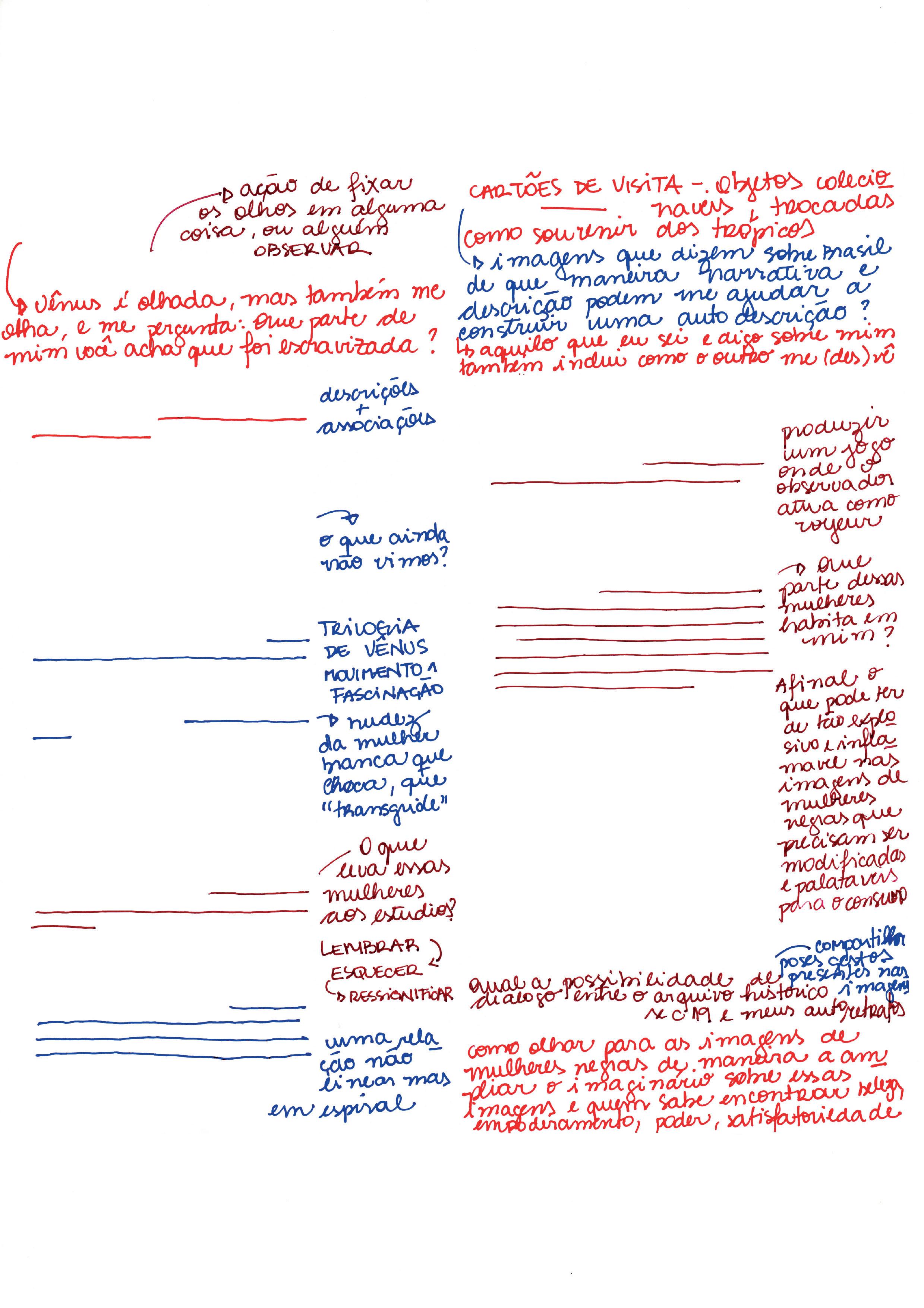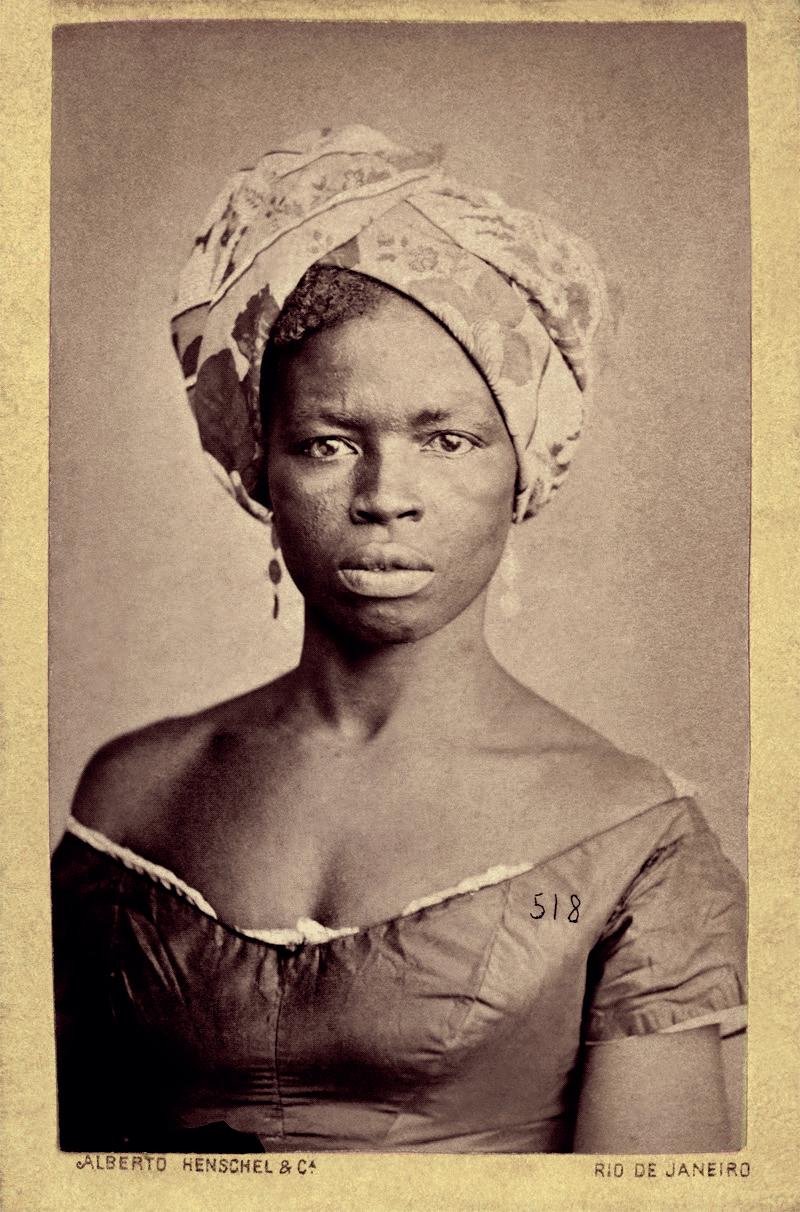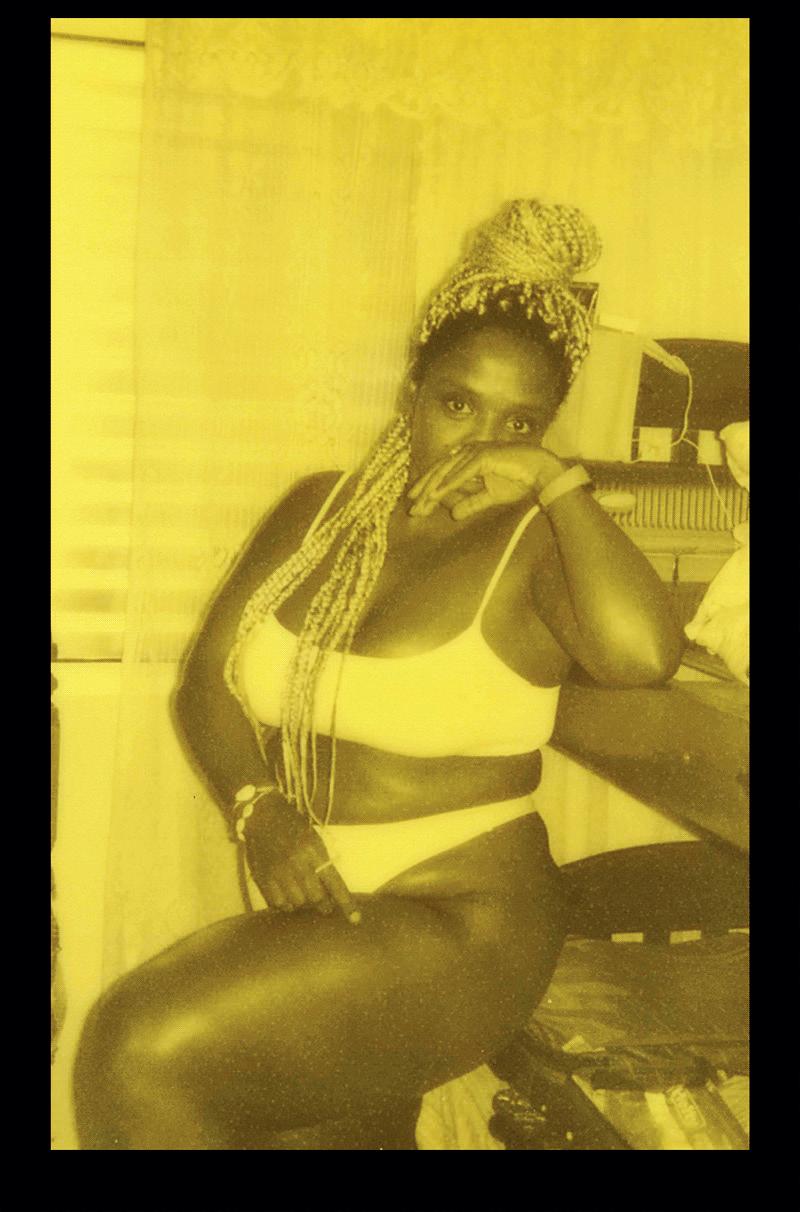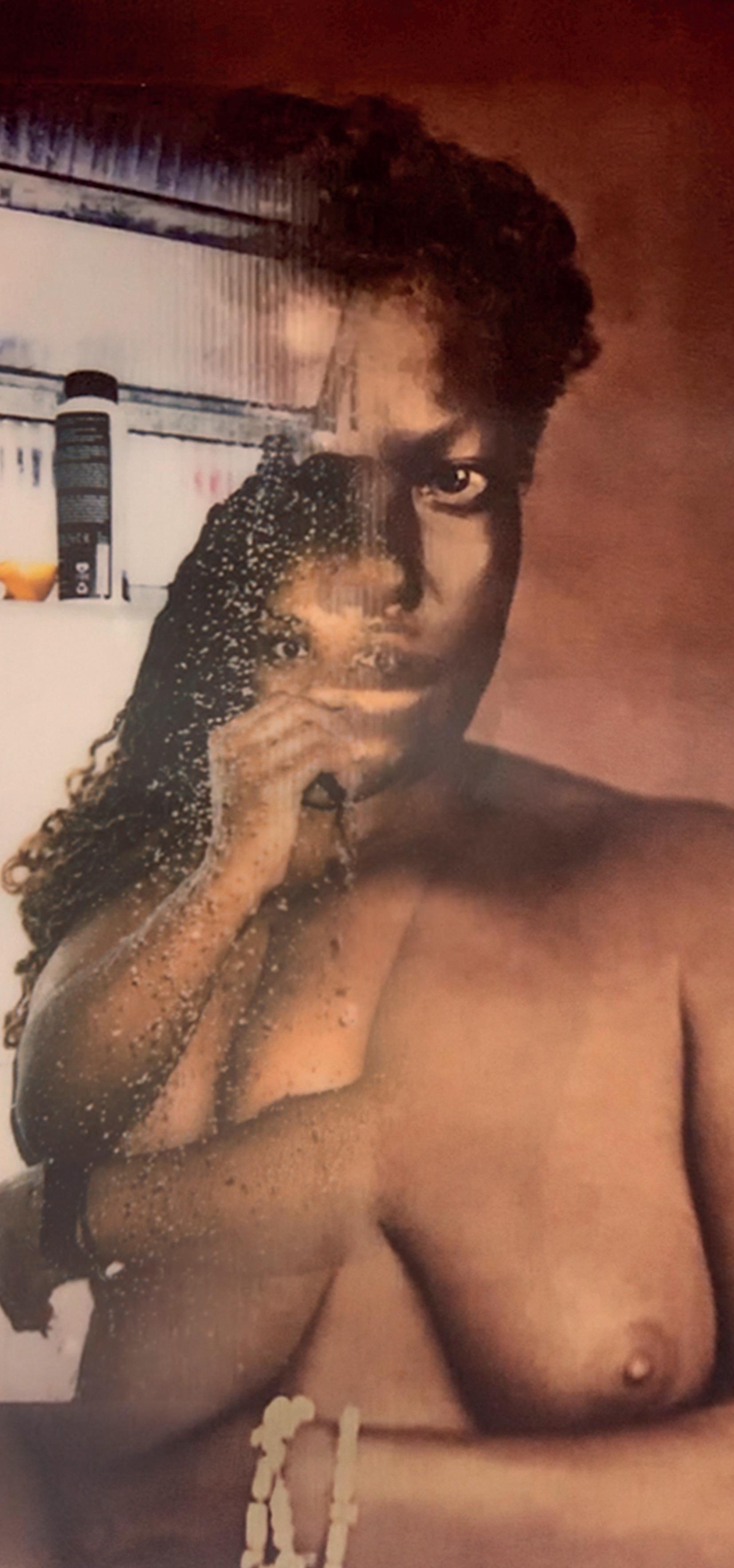







Vênus como mirada apresenta uma intensa pesquisa da artista Val Souza sobre os mecanismos de formação dos imaginários e construções de noções históricas utilizadas para representação da mulher negra em relação direta com os padrões de beleza, amor e erotismo vigentes no mundo ocidental em consequência das heranças coloniais e ainda presentes como um reflexo dos modelos gregos de percepção sobre os corpos.
Pensar sobre os processos de representação, regimes de imagem e modelos de percepção que estiveram secularmente hierarquizados, estabelecendo formas de poder pela coerção, censura e discriminação a modos de ser e expressões sensíveis diversas daquelas socialmente hegemônicas é propor uma revisão em todo um sistema de valores éticos, estéticos, históricos, culturais e políticos que impactam as relações humanas por meio da dimensão simbólica na vida em sociedade.
Os atributos da divindade grega Vênus, amor, beleza e erotismo, sempre estiveram em disputa, sendo utilizados como instrumentos de controle dos desejos e negociações políticas a serviço dos interesses das elites coloniais, acadêmicas, culturais, financeiras etc., de cada época, por meio da imposição de normativas estéticas e estereótipos segregacionistas, monorrepresentativos e generalizantes. Neste trabalho, a artista promove o encontro entre uma série de autorretratos, evocando performaticamente a presença de Vênus em si própria, com retratos produzidos no Brasil pelo fotógrafo alemão Alberto Henschel, na segunda metade do século XIX, nos quais as mulheres ali representadas tiveram suas identidades ocultadas, subtraídas. Utilizando a técnica de impressão lenticular, Val Souza constrói um espaço de combinação pictórica em que duas imagens, feitas em momentos históricos distintos, passam a se relacionar de forma interdependente, uma completando a existência da outra. Imagens lenticulares são construídas a partir da interseção de duas ou mais fotografias impressas em lentes especiais que

permitem a percepção alternada de cada cena, dependendo do ângulo de observação. No processo de fruição da obra, as imagens, para serem vistas, cedem lugar uma à outra, sem deixarem de existir simultaneamente no mesmo plano material. Apesar de estarem em constante transição no campo de visão do observador, que se desloca para descobrir a próxima cena, e se manifestarem alternadamente à percepção de quem as vê, as duas imagens nunca deixam de estar associadas, de se pertencerem. Nas camadas poéticas do trabalho, que dizem respeito à transformação dos sentidos e valores estéticos, compartilhar o mesmo espaço pictórico ou dividir o mesmo plano da imagem seria incorporar em si a dimensão existencial de Outro. O gesto da artista, de se colocar autorrepresentada em relação aos retratos históricos dessas mulheres, recontextualizando sua presença e a maneira como são percebidas, sem alterar suas identidades, pode ser encarado como um fenômeno de incorporação que transcende a superfície do quadro e as noções tradicionais de temporalidade. Dois corpos se encontram – separados por séculos de distância entre si –para se tornarem uma única entidade simbólica. Val empresta a elas uma identidade enquanto reafirma a sua própria no encontro com essas mulheres. Cria-se, portanto, entre esses dois pontos da história, uma relação ético-estética de reciprocidade e completude de desejos. Nesse movimento de interseção entre imagens e tempos, Val Souza transfere a essas mulheres do século XIX, no mesmo instante em que recebe delas, suas dimensões de beleza, amor e afetividade. Se fazem simultânea e alternadamente signo e símbolo uma da outra. A partir do que todas elas se tornam Vênus.
Guilherme Cunha (a partir da obra de Val Souza)


Sem título
Untitled Fotografia em impressão lenticular
Da série: Vênus como mirada / Acervo / Collection Museu da Imagem
ACERVO HISTÓRICO MOBILIZADO
Henschel.
-
SOUZA

título 4, 2023
Untitled 4
lenticular / Lenticular print photography
From the series: Venus as gaze
Imagem e do Som (MIS) de São Paulo
MOBILIZADO / HISTORICAL COLLECTION:
- Mulher negra de turbante
turban, Rio de Janeiro (RJ), c. 1870.
Photography
Collection Gilberto Ferrez
Instituto Moreira Salles
Venus as Gaze presents artist Val Souza’s intensive research into the mechanisms that shape the formation of imaginaries and historical constructions used to represent Black women. In direct relation to the standards of beauty, love, and eroticism that prevail in the Western World, these representations are also molded by colonial legacies and the persistent influence of Greek models of the body.
To reflect critically on processes of representation, image regimes, and models of perception that have been hierarchically structured for centuries — establishing forms of power that use coercion, censorship, and discrimination against non-hegemonic modes of expression and being — implies the revision of an entire system. A system of ethical, aesthetic, historical, cultural, and political values that impact human relations through the symbolic dimensions of life in society. The attributes of the Greek deity Venus — love, beauty, and eroticism — have always been an object of struggle.They have been used as instruments of control over desires, and in political negotiations serving the interests of the colonial, academic, cultural, and economic elites each era, through the imposition of aesthetic norms and segregationist, monolithic, and generalizing stereotypes.
In this work, the artist brings together a series of self-portraits, performatively evoking Venus’s presence in the artist herself. To do so, she uses portraits done in Brazil, in the second half of the 19th century, by German photographer Alberto Henschel,in which the identities of the women portrayed are concealed, excised.
Using the technique of lenticular printing, Val Souza constructs a pictorial space where two images, made at different historical moments, come to relate in an interdependent way, one completing the existence of the other
A.N. 1 Venus is looked at, but she looks at me too, and asks me: what part of me do you think was enslaved?
A.N. 2 To fix your eyes on something, or someone. OBSERVE.
A.N. 3 Descriptions + associations
A.N. 4 What haven’t we seen yet?
A.N. 5 VENUS TRILOGY / MOVEMENT 1 / FASCINATION
A.N. 6 Nudity of the white woman that shocks, that “transgresses”.
A.N. 7 What brings these women to the studios?
A.N. 8 REMEMBER > FORGET > RESIGNIFY
A.N. 9 A relation that is not linear, but spiral.
Lenticular images are built from the intersection of two or more photographs printed on special lenses that allow the alternating perception of each scene, depending on the angle of observation.
As one observes the artwork, images give way to one another, while continuing to coexist on the same material plane. Although kept in constant transition within field of view of an observer who moves on to discover the next scene — and who captures now one, now another — the two images never cease to be associated, to belong to each other.
Within the poetic layers of the work, which concern the transformation of meanings and aesthetic values, sharing the same pictorial space or the same image plane means incorporating the existential dimension of the Other.
The artist's gesture of self-representation in relation to these historical portraits of women, recontextualizing their presence and the way they are perceived without altering their identities, can be seen as a phenomenon of incorporation that transcends the surface of the painting and traditional notions of temporality. Two bodies meet — separated by centuries of distance between them — to become a single symbolic entity. Val lends them an identity while reaffirming her own in her encounter with them. Thus, a reciprocal ethical and aesthetic relationship and a completeness of desires connect these two points in history.
In this movement of intersection between images and times, Val Souza transfers to these 19th century women, while at the same time receiving from them, dimensions of beauty, love, and affection. They become, simultaneously and alternately, sign and symbol of one another. Hence, they all become Venus.
Guilherme Cunha (from work by Val Souza)
A.N. 10 BUSINESS CARDS – Collectible objects exchanged as a souvenir from the tropics. Images that tell about Brazil. How can narrative and description help me build a self-description? What I know and say about myself also includes how the other (un)sees me.
A.N. 11 Make a game where the observer acts as voyeur.
A.N. 12 What part of these women inhabits me?
A.N. 13 Afterall, what can be so explosive and flammable about images of black women, which need to be modified and made palatable for consumption?
A.N. 14 Sharing poses, gestures, that are present in the images.
A.N. 15 What is the possibility of dialogue between the historical archive from the 19th century and my self-portraits?
A.N. 16 How to look at images of black women in order to expand the imaginary about these images and, who knows, find beauty, empowerment, power, satisfactoriness?
*A.N. - Artist's notes
Lançado pelo Museu Paranaense (MUPA) em 2020, o Edital de Ocupação do Espaço Vitrine é um projeto que tem como objetivo receber propostas expositivas nas áreas de Artes Cênicas, Artes Visuais, Design, Arquitetura e Pesquisa, colocadas em diálogo com as disciplinas científicas da instituição – Antropologia, Arqueologia e História. A partir desse encontro, promove-se a interdisciplinaridade entre os campos de atuação mais tradicionais do museu e os diferentes fazeres contemporâneos.
Em 2024, o conceito norteador "Interlúdio" busca suscitar o debate sobre o visível, o invisível (oculto, submerso, encoberto) e aquilo que pode estar prestes a emergir, não sendo aparente à primeira vista. Procura-se, assim, estimular o criar e o pensar sobre as decisões envolvidas no mostrar e no não mostrar, transpondo fronteiras entre o real e a ficção, o conhecido e o inverossímil, o palpável e o simbólico.
Dessa maneira, o ver, o fazer e os seus entremeios inspiram a quarta edição deste edital, cujas três propostas selecionadas ocupam o espaço do MUPA ao longo do ano. A primeira delas, “Vênus como mirada”, de Val Souza, fica em exibição de 22 de setembro a 8 de dezembro.
Museu Paranaense
Launched by the Museu Paranaense (MUPA) in 2020, the Public Call for use of the Showcase Space is a project which targets exhibition proposals in the fields of Performing Arts, Visual Arts, Design, Architecture, and research, to dialogue with the institution’s scientific disciplines –Anthropology, Archaeology, and History. Through this encounter, interdisciplinary conversations between the museum's more traditional fields of activity and various contemporary practices are promoted.
In 2024, our guiding concept "Interlude" seeks to provoke debate about the visible, the invisible (the hidden, the submerged, the covered), and that which may be about to emerge, not readily visible at first sight. Our aim is to stimulate creative thinking about the decisions that underlie showing and not showing, transcending boundaries between the real and the fictional, the known and the unreal, the tangible and the symbolic.
In this way, seeing, doing, and their interplay inspire the fourth edition of this Public Call. The three proposals that are selected will occupy MUPA space throughout the entire year. The first one, “Vênus como mirada”, by Val Souza, will be exhibited from September 22nd to December 8th





Artista / Artist
Val Souza
Texto crítico / Critical text
Guilherme Cunha
Revisão / Proofreading
Mônica Ludvich
Tradução / English Version
Miriam Adelman
Lucas Adelman Cipolla
Apoio / Support
Museu da Imagem e do Som (MIS) de São Paulo
Agradecimentos da artista
The artist thanks
A todas as mulheres negras que sonharam que seria possível (aqui estou!); a todos os apoiadores da minha pesquisa; à equipe do MUPA e aos jurados do IV Edital de Ocupação do Espaço Vitrine; aos queridos Fabiana Moraes e Guilherme Cunha (que os bons encontros nos encontrem sempre, abertos e dispostos); à equipe do MIS-SP; à equipe do Instituto Moreira Salles (IMS), pelas muitas ajudas durante a pesquisa e que se estendem até hoje; à equipe da Bolsa ZUM, meu time preferido sempre! Se eu puder dar um conselho a todas as pessoas negras: voltem e peguem!
To all the black women who dreamed it would be possible (here I am!); to all supporters of my research; to the MUPA team and the judging committee of the 4th Public Call for Use of the Showcase Space; to dear Fabiana Moraes and Guilherme Cunha (may good encounters always find us open and willing); to the MIS-SP team; to the Instituto Moreira Salles (IMS) team, for their great assistance during my research, which extends to this day; to the Bolsa ZUM team, my favorite team ever! If I can give one piece of advice to all black people: go back and get it!
IV Edital de Ocupação do Espaço Vitrine
IV Public Call for Use of the Showcase Space
Concepção e projeto
Concept and project
Museu Paranaense
Comissão julgadora
Judging committee
Convidados (as) / Guests
Antonio Gonzaga Amador
Jandir Jr.
Fabrícia Jordão
Equipe MUPA / Staff
Heloisa Nichele
Richard Romanini
Governador do Estado do Paraná
Governor of the State of Paraná
Carlos Massa Ratinho Junior
Secretária de Estado da Cultura
State Secretary of Culture
Luciana Casagrande Pereira
Diretora-Geral da SEEC
General Director of SEEC
Elietti de Souza Vilela
Diretor de Memória e Patrimônio
Director of Memory and Heritage
Vinicio Costa Bruni
Coordenador do Sistema
Estadual de Museus
Coordinator of the Museums
State System
Marcos Coga da Silva
Assessoria de Comunicação
Communication Consulting
Fernanda Maldonado
MUSEU PARANAENSE
Diretora / Director
Gabriela Bettega
Diretor Artístico / Artistic Director
Richard Romanini
Gestão de Conteúdo e Comunicação
Content Management and Communication
Beatriz Castro
Heloisa Nichele
Núcleo de Arquitetura e Design
Architecture and Design Division
Juliana Ferreira de Oliveira
Estagiária / Interns
Isabella Barbosa de Melo
Núcleo de Antropologia
Anthropology Division
Coordenadora / Coordinator
Josiéli Spenassatto
Estagiária / Intern
Maria Eduarda Rodrigues
Núcleo de Arqueologia
Archaeology Division
Coordenadora / Coordinator
Claudia Inês Parellada
Núcleo de História
History Division
Coordenador / Coordinator
Felipe Vilas Bôas
Residente técnico / Technical resident
João Guilherme Züge
Estagiários / Interns
Gabriella Perazza
Felipe C. de Biagi Silos
Núcleo Educativo
Educational Division
Milena Aparecida Chaves
Roberta Horvath
Marília Alves de Abreu
Yohana Rosa
Estagiários / Interns
Helena Nassabay Pereira
Lucas Plaza da Rosa
Thiago Silvestre
Vitor Emanuel W. Souza
Wesley da Silva
Gestão de Acervo
Collection Management
Denise Haas
Laboratório de Conservação
Conservation Laboratory
Esmerina Costa Luis
Janete dos Santos Gomes
Supervisor de Infraestrutura
Infrastructure Supervisor
Rogério Rosário
Setembro — Dezembro 2024

Terça a domingo Tuesday to Sunday 10h —17h30
Entrada gratuita Free admission
Rua Kellers, 289 Alto São Francisco Curitiba, Paraná, Brasil
+55 (41) 3304 3301 museupr@seec.pr.gov.br museuparanaense.pr.gov.br museuparanaense
